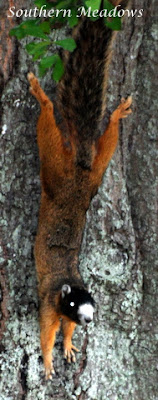Wildflower Wednesday: Amorpha fruticosa
As May draws to a close, it's time celebrate native wildflowers.
This month, I'm sharing our Amorpha fruticosa, also known as False
Indigo Bush. In nature, this upright forming shrub grows in moist open
woodlands, floodplains, along river banks and edges of swamps in most of U.S.
States and Eastern Canada. The first time I saw this shrub was along Lake Hartwell
(Georgia), while teaching a native plant merit badge class at my sons' Scout
camp. I knew I needed one for our garden.
We had a perfect spot for it to grow at the edge of a dry creek
bed that often sees heavy water flow from rainfall or when we back wash our
pond. A few years ago, I finally found one at a local, native plant sale.
Score!
In our garden, it receives part sun, sheltered from late afternoon
sun by the surrounding paw paw trees and stately red oak. The deep purple
flowers contrasted with orange anthers bloom in spring. From late April through
May, they provide rich nectar for all sorts of pollinators; bees, butterflies
and beneficial insects.
The leaves indicate it is a member of the Fabaceae (Pea) family
with its alternate, compound arrangement. The silver-spotted skipper and
dogface sulphur butterflies use this shrub as a host plant for their larval
stage, as do several species of moths and beetles (long-horned beetle).
Described as 'leadplant' (Amorpha canescens) on
steroids, Amorpha fruticosa is a vigorous growing, deciduous
shrub that will form thickets where there is suitable moisture; yet is tolerant
of a range of soils from poor/dry to moist/damp areas. Its extensive root
system makes it useful as a windbreak or to prevent soil erosion. It has a
symbiotic relationship with certain soil bacteria, which form nodules on the
roots and fix atmospheric nitrogen. This shrub will use some of this nitrogen,
but it also shares with plants nearby.
In 2019, at the Garden Blogger Fling in Denver, I saw what this
plant will look like at maturity. The branches danced against the bright
blue sky, showing off the fabulous flowers.
I am looking forward to this specimen reaching these heights in
our garden.







